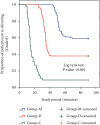A Randomized Controlled Trial for Prevention of Postspinal Anesthesia Shivering in Gynecological Surgeries: Mirtazapine vs. Dexamethasone
- PMID: 35310422
- PMCID: PMC8926546
- DOI: 10.1155/2022/5061803
A Randomized Controlled Trial for Prevention of Postspinal Anesthesia Shivering in Gynecological Surgeries: Mirtazapine vs. Dexamethasone
Abstract
Background: The frequency of shivering regarding regional anesthesia is 55%. Newer effective and tolerable options for postspinal anesthesia shivering (PSAS) prophylaxis are necessary to improve patients' quality of care. This research assessed the impact of preemptive mirtazapine versus preemptive dexamethasone to decrease frequency and severity of PSAS in gynecological procedures.
Methods: 300 patients booked for gynecological procedures under spinal anesthesia (SA) were randomly apportioned into three groups (100 each) to get one preemptive dose of 30 mg mirtazapine tablet (M group), 8 mg dexamethasone diluted in 100 ml of saline infusion (D group) or placebo (C group) two hours before surgery. Incidence of clinically significant PSAS was the primary outcome. Core temperature, shivering score, hemodynamics changes, adverse events, and patient satisfaction score were documented as secondary outcomes.
Results: Compared with C group, mirtazapine and dexamethasone decreased incidence of clinically significant shivering (74% vs. 16% and 31%, respectively; P < 0.001). M and D groups had less hypotensive episodes during 5-25 min after intrathecal injection (P < 0.001). 90 min after SA, tympanic temperatures were lower than baseline values in the three groups (P < 0.001). Pruritus, nausea, and vomiting were more often in C group (P < 0.001), whereas sedation was more frequent in M group (P < 0.001). C group had the lowest satisfaction scores (P < 0.001).
Conclusion: Prophylactic administration of mirtazapine or dexamethasone attenuated shivering with minimal hazards in patients scheduled for gynecological surgeries under spinal anesthesia with priority to mirtazapine. The trial is registered with NCT03675555.
Copyright © 2022 Ibrahim M. Esmat et al.
Conflict of interest statement
The authors declare that they have no conflicts of interest.
Figures






Similar articles
-
Postspinal anesthesia shivering in lower abdominal and lower limb surgeries: a randomized controlled comparison between paracetamol and dexamethasone.BMC Anesthesiol. 2021 Oct 30;21(1):262. doi: 10.1186/s12871-021-01483-7. BMC Anesthesiol. 2021. PMID: 34717535 Free PMC article. Clinical Trial.
-
Intrathecal dexamethasone vs. meperidine for prevention of shivering during transurethral prostatectomy: a randomized controlled trial.Acta Anaesthesiol Scand. 2017 Aug;61(7):749-757. doi: 10.1111/aas.12920. Epub 2017 Jun 18. Acta Anaesthesiol Scand. 2017. PMID: 28626868 Clinical Trial.
-
Prophylactic granisetron for post-spinal anesthesia shivering in cesarean section: A randomized controlled clinical study.Acta Anaesthesiol Scand. 2019 Mar;63(3):381-388. doi: 10.1111/aas.13084. Epub 2018 Feb 8. Acta Anaesthesiol Scand. 2019. PMID: 29424008 Clinical Trial.
-
A comparison of prophylactic use of meperidine, meperidine plus dexamethasone, and ketamine plus midazolam for preventing of shivering during spinal anesthesia: a randomized, double-blind, placebo-controlled study.J Clin Anesth. 2016 Nov;34:128-35. doi: 10.1016/j.jclinane.2016.03.036. Epub 2016 May 3. J Clin Anesth. 2016. PMID: 27687359 Clinical Trial.
-
Effect of prophylactic dexamethasone on nausea and vomiting after laparoscopic gynecological operation: meta-analysis.Middle East J Anaesthesiol. 2011 Oct;21(3):397-402. Middle East J Anaesthesiol. 2011. PMID: 22428495 Review.
Cited by
-
The Effect of Intravenous Dexmedetomidine During Surgery in the Prevention of Shivering After General Anesthesia in Patients Undergoing Spinal Surgery: A Randomized Clinical Trial.Anesth Pain Med. 2025 May 18;15(2):e159077. doi: 10.5812/aapm-159077. eCollection 2025 Apr 30. Anesth Pain Med. 2025. PMID: 40717905 Free PMC article.
-
Examining the efficacy of intravenous ibuprofen and meperidine for preventing post-operative shivering after laparoscopic cholecystectomy with general anesthesia.J Med Life. 2023 Jul;16(7):1041-1046. doi: 10.25122/jml-2022-0040. J Med Life. 2023. PMID: 37900063 Free PMC article. Clinical Trial.
-
Evidence-Based Guideline on Prevention and Management of Shivering After Spinal Anesthesia in Resource-Limited Settings: Review Article.Int J Gen Med. 2022 Sep 5;15:6985-6998. doi: 10.2147/IJGM.S370439. eCollection 2022. Int J Gen Med. 2022. PMID: 36090703 Free PMC article. Review.
-
Novel therapies for nausea and vomiting in advanced illness and supportive cancer care.Palliat Care Soc Pract. 2024 Jun 6;18:26323524241257701. doi: 10.1177/26323524241257701. eCollection 2024. Palliat Care Soc Pract. 2024. PMID: 38855566 Free PMC article. Review.
References
-
- Mark C. Barash PG. Clinical Anesthesia . 8th. Philadelphia, PA, USA: Lippincott: Williams & Wilkins; 2017. Norris. Neuraxial anesthesia; pp. 2273–2343.
Associated data
LinkOut - more resources
Full Text Sources
Medical

